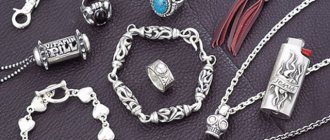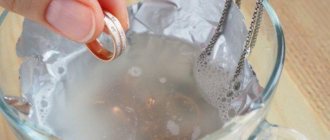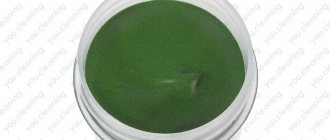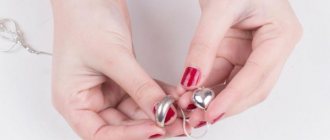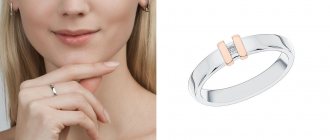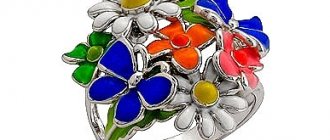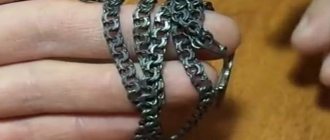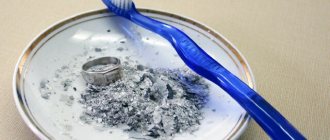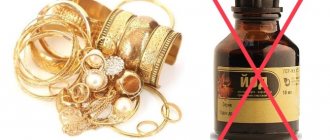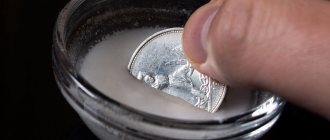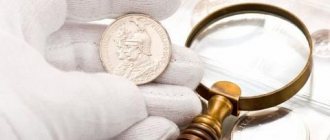Silver has turned black - how to clean it at home: useful tips
Silver items are easily exposed to hydrogen sulfide in the air. Please note that hydrogen sulfide compounds are found in many cosmetics.
Silver must be kept clean. Clean it from dust and dirt at least a couple of times a month. This applies to cutlery, dishes, icons, figurines, and jewelry.
Here are some ways to keep your silver items clean:
- If your silver items become dirty from sand, dust or cosmetics, place them in a container of warm water.
- Add a few drops of liquid detergent there and leave them to soak for a couple of hours.
- During this time, the soap solution will penetrate into all hard-to-reach areas
- Next, clean the products with a soft brush. Rinse under running water and dry with a towel
- For the purpose of prevention, as well as removing shallow dirt, ordinary water and baking soda will help you.
- Wet the silver item and sprinkle it with a small amount of baking soda. Take a cotton cloth and rub the product
- A bottle of ammonia (10%) is poured into a small container. Silver jewelry is also placed there.
- It is better to put the ammonia mixture on the balcony or in places where you will not breathe the pungent odor
- The solution with the products is left for a period of half an hour to 3 hours. Then all products are removed and washed under water
- One of the newest methods for prevention in cleaning silver is the use of highly carbonated drinks.
- Typically, Sprite, CocaCola and other fizzy drinks are chosen. A bottle of sparkling water is poured into a saucepan
- Silver utensils and jewelry are placed there. The liquid is brought to a boil, and then all products are removed. Wash with water and dry with a cotton towel
- Window cleaner is great for cleaning all types of silver. A few pumps of the bottle must be sprayed onto the silver object.
- Wait until the chemical begins to eat away the dirt and rub the contaminated areas. After the procedure, rinse the product with water and wipe dry with a towel.
Home methods
Housewives often choose home methods for cleaning silver due to the simplicity and availability of folk recipes, as well as the ecology of the selected products, which do not leave chemicals on precious metals.
Soda
Using baking soda is one of the effective ways to clean the kitchen. It also works well to remove tarnish on silver.
- Pour liquid soda until a slurry appears, apply it to a sponge or cloth and clean the products until the plaque is removed. Then rinse thoroughly to remove stains. At the same time, you need to be careful with matte and smooth objects; traces of soda may remain.
- Dilute 2 standard spoons of soda per half liter of water solution. Wait until it boils, remove from heat, place things in a container. You also need to add a piece of foil there. After 10-20 minutes, remove the products and rinse.
Soda baths and boiling are often used when processing not only silver, but also gold.
Foil
Cut kitchen foil into medium squares and add a teaspoon of moistened baking soda to the middle of each square. Then put things in and cover with foil to make an envelope. Throw into boiling water for 10-20 minutes, remove, cool, and then rinse and wipe with a special cloth.
Ammonia
The effectiveness of ammonia has been proven by more than one generation of housewives and jewelry lovers. To remove plaque, just take 2 standard spoons of the specified alcohol, dilute it with a liter of water, then put all the Argentum things into the resulting solution. Another way is to add a teaspoon of hydrogen peroxide and a drop of detergent to the existing solution. Immerse the products in it for 10-20 minutes and then rinse.
Blackening of a silver chain and methods for cleaning it
Hydrogen peroxide
One of the aggressive treatments is suitable for simple, low-grade items. Dilute peroxide at 3% concentration in a warm water bath. Place all darkened metals there. After 5 minutes, remove and rinse and dry. When working with peroxide, you should wear gloves to avoid getting burned.
Vinegar
Pour vinegar (3 percent solution) into a deep plate. Then heat the silver items a little and lower them into the liquid. After 15 minutes, remove and rinse in distilled liquid and polish. If there is no specified percentage of vinegar, you can take a 6% solution and dilute it with water.
You can also wipe with a cloth soaked in vinegar, but to achieve effectiveness, it is better to immerse it in heated water.
Tooth powder and paste
Teeth whiteners are great for cleaning cutlery. The paste removes sulfide film well. You can take a small amount of paste, a soft toothbrush or cloth and rub gently.
Lemon acid
An aggressive substance that can even harm silver. If used correctly, this is impossible. You need to dissolve 100 g of dry acid per half liter of liquid. At the same time as the silver items, throw in a copper wire (a small piece) and heat it in a steam bath. After 15 minutes, remove and rinse with distilled liquid. Then polish it.
Other acid
Formic acid, like other acids, can be used in the processing of silver. Dilute formic acid at 5% concentration in a warm water bath. Leave for 5 minutes, rinse and dry.
Salt
Pour two tablespoons of salt into half a liter of liquid. Drown everything blackened in the solution and leave for 2-3 hours or bring to a boil in 20 minutes. Then rinse and dry
Coca Cola
The famous lemonade has long been used to remove dirt and clean dishes. The drink is also effective in purifying precious metals. Place the products in a container filled with sizzling liquid for 20 minutes. Another way is to bring the drink to a boil and put silver in it for 15-20 minutes.
Potato
An effective folk method is peeling potatoes. Grind a couple of potatoes until a paste forms, add water to the resulting mixture and soak for 10-15 minutes. Afterwards, strain the solution and immerse objects in it for 20 minutes.
This method works well for minor stains.
Olive oil
Olive oil is used when you need to clean expensive silver items with a slight coating. Apply a little oil to cotton wool or a cloth and wipe the stained areas on the products with it. This method is only suitable for minor darkening; in other cases, the oil may not cope.
Eraser
The eraser is used as the last stage of cleaning, for example, after boiling or treating with soda. Using an eraser, simply erase the remaining stains on the products until they disappear completely.
Boiling
Boiling is used for deep contamination when other methods do not work. Most often, soda and salt solutions, as well as foil, are used for boiling. Some housewives add household chemicals.
To boil, take 2 tablespoons of baking soda, 2 tablespoons of salt, and a little dishwashing detergent. Place all this in a saucepan and add 0.5 liters of water. Bring the solution to a boil, and then place silver items in it. After 5 minutes, remove, rinse and wipe dry.
Chalk
The chalk is crushed and mixed with ammonia. The resulting mixture is applied to the silver with a brush or sponge and rubbed until the plaque is removed.
Egg
Place the decorations in the liquid in which the eggs were previously boiled and leave for 15-20 minutes. Take it out and wipe it with a cloth.
Take a raw egg, separate the yolk from the white, then soak the yolk in cotton wool and wipe things with it. Leave in the yolk for a while and then rinse.
Ash and ashes
Dip a damp cloth into ash or ash and apply it to things, then rub with ash until dirt and stains are completely removed. Then rinse and dry.
Curdled milk
Place silver items in regular yogurt and leave for 20 minutes. Then rinse and dry.
Ketchup
Place things in ketchup for 15-20 minutes, take a sponge or cloth and wipe all hard-to-reach places, as well as dirt. Leave for another 5-10 minutes. Then wash in soapy water and polish.
Lipstick
No matter how paradoxical it may sound, lipstick cleans small objects well: rings, earrings, pendants. Apply lipstick to a napkin or cloth, then wipe the jewelry with it, then rinse thoroughly.
Cosmetic powder
Regular women's powder cleans silver items well. You need to pour a little powder onto a cloth and rub the jewelry with it until the stains disappear. This method is well suited for small silver jewelry.
Cleaning blackened silver
How to clean silver jewelry at home?
When cleaning contaminated silver items, whether it is yellow, brown or black, you must take into account the fact that the silver should be cleaned in a way that is suitable for the alloy. Silver alloys are divided:
- sterling (with 7.5% copper added)
- coin
- filigree
- blackened
- matte
Focusing on the composition of silver jewelry, you should also not forget about the presence of stones. Products with such components should be subjected to gentle processing only. In general, silver is a soft metal, so you shouldn’t use hard abrasives to clean it.
Cleaning silver at home should be done delicately so as not to harm the product.
Therefore, make a test on the inside of the product, putting an end to any of the above mentioned cleaning agents. If the silver alloy does not react with the cleaning agent (does not darken or change color), then you can safely clean the product with any of the above listed products.
Properties of silver
Metal is wonderful to work with: it is easy to process, polish, twist, cut, roll into thin plates, and stretch. These parameters are unique in the manufacture of jewelry masterpieces.
For the strength of the products, a silver alloy with the addition of copper is used. The softness of the material can lead to various deformations, bending, darkening, turning black. To protect products from darkening, it is necessary to clean them regularly.
How to clean silverware with baking soda: recipe
Silver cutlery, as a rule, does not contain inlay. Therefore, you can clean them using any suitable means for such a soft metal as silver.
- You can clean silver cutlery by placing it in a saucepan with a capacity of at least 3 liters.
- First, all the side walls and bottom of the vessel are lined with foil (you can use regular baking foil)
- Then silver utensils or jewelry are laid out there
- Top all items with 4 tablespoons of baking soda (you can find it in any grocery store if you don’t have it at home)
- Now fill everything with water, cover the top with a sheet of foil (build a “lid”) and set to boil
- As soon as the container with silver reaches a boil, turn off
- In this form, the mixture should stand for 20 minutes. Then the silver is removed and washed under running water with a washcloth.
How to clean silverware with salt: recipe
- If you don’t have either vinegar or soda, then table salt will help you
- To do this, take 3 tablespoons of salt and 3 glasses of water.
- Place this in the pan along with the cutlery
- Bring to a boil and boil in a bubbling solution for 15 minutes
- Then take out the utensils and dry them with a cotton towel
How do experts clean silver items?
If a set of silverware is of considerable age and is a rarity and quite valuable, you should seek help from qualified specialists. The jewelry workshop employs people who know exactly how to clean silver spoons and forks, so as not only not to harm their appearance, but also to preserve their beauty for many years.
The process of cleaning silver items in jewelry workshops is as follows:
- Specialists use ultrasonic metal cleaning, which allows you to easily remove plaque and completely clean all inclusions of dirt. The effectiveness of this method is higher than all home methods combined.
- In addition, a steam generator is often used. This device works well with cutlery, which, in addition to plaque, contains on its surface traces of fat and residues of pastes used for polishing products of this kind. Moreover, this method gives a better result than the use of ultrasound.
- It is not enough to just clean cutlery made from silver. It is equally important to polish them thoroughly. For this, craftsmen use napkins soaked in special compounds, which give a sparkling shine to the products. A spoon or fork, cleaned in a workshop, will shine no worse than a new one.
How to clean silverware with toothpaste?
- Toothpaste has wonderful cleansing properties
- But when choosing this ingredient, you should take only pasty white pastes
- Gels and colored inclusions are not suitable
- Only cutlery and embossed silver surfaces can be cleaned with the paste.
- The paste is not suitable for other items made of this metal, as it can scratch the shiny silver surface. For the procedure, soak the cutlery in water
- Then take them out and rub with a damp cloth with a paste solution
- Periodically rinse and re-wipe appliances with toothpaste
How to clean silverware with citric acid: recipe
- You can also clean silverware using citric acid.
- Half a liter of water is poured into a saucepan. Add 100 g of citric acid powder
- Bring to a boil. Turns off
- Then you can immerse the cutlery and keep them there for half an hour
- After “cleaning”, rinse with water and dry with a waffle towel.
How to save your cleaning results
Blackness on cutlery occurs due to interaction with other substances, which include air, water and, of course, unsuitable detergents.
Therefore, after cleaning, each device is individually dried with paper napkins. Then, if possible, also individually, the devices are wrapped in cling film or foil.
Only oil-impregnated paper guarantees 100% neutralization and prevention of blackening. If silver is used infrequently, it is recommended to use this method of preservation. Just two days before the holidays, remove the utensils from the paper and wash them.
Cupronickel, stainless steel and silver should be stored separately.
And, of course, do not forget to follow the important rules: darkness, moderate humidity and coolness.
How to clean silver in items with stones, baby soap and laundry soap: recipe, useful tips
Stones in silver jewelry add charm and sophistication. But many people don’t even think that these products need to be cleaned in a special gentle way.
- Prepare a bar of baby soap, grate it
- Place 1 tablespoon of shavings in 2 glasses of water and stir until dissolved
- Dip silver jewelry with stones into a soapy solution
- 2 hours is enough to clean soiled jewelry.
- After this time has passed, remove the silver and rinse
- Then wipe with a microfiber cloth
- Silver jewelry with emeralds, pearls and rubies should not be cleaned in hot solutions
- Fill a small container with warm water. Immerse the jewelry in there and after an hour and a half to two hours you can take them out again
- Wipe the items with a canvas cloth
- If desired, you can add a small amount of laundry soap and leave for an hour
- Silver jewelry with coral needs to be cleaned around the stone
- Immersing them in solutions is not recommended. These stones are very sensitive even to sunlight, and if they are in solution they can lose their color
- Therefore, choose a soda solution, tooth powder or ammonia for cleaning, which will be discussed below.
How to clean silver with ammonia: recipe
One of the most common ways to clean silver jewelry is with an ammonia solution. You can purchase such a solution at any pharmacy and use it at home according to one of the recipes below.
- 10% ammonia solution in proportions of 1 tsp. mix 100 g of water in a cup or glass
- Immerse silver jewelry there for 2-3 hours
- After this, use tweezers to remove the products and rinse them in water.
- For greater effectiveness, you can mix ammonia with tooth powder.
- Mix 5 tablespoons of warm water, 2 teaspoons of tooth powder and 2 tablespoons of ammonia
- Dip a piece of an old cotton T-shirt or other cotton fabric into the prepared solution.
- Wipe the product with a dampened cloth until it is clean. Then rinse it under water and dry it with a towel
- After rinsing in a soapy solution, you can place silver items coated with black in an ammonia solution with chalk
- This is done like this: add 2 tablespoons of ammonia solution to 5 tablespoons of water.
- Add a teaspoon of crushed chalk to them.
- Soak a piece of soft cloth in this mixture
- Wipe the product with it until clean. Then rinse and dry clean items
Effective detergents
As mentioned above, in the case of silverware, you cannot use ordinary detergents - they can leave unsightly dark stains. Avoid using abrasives as they will scratch delicate surfaces.
The matter is further complicated by the fact that silverware (especially antique ones) often have intricate decorations. And we’re not just talking about all kinds of curls, reliefs and indentations. Silverware was often decorated with decorative blackening or gilding, and the metal was combined with ivory and precious wood.
Nevertheless, in every home you can find effective and safe means for caring for silverware (including antique silver).
If antique silver has a purely decorative function, it is not necessary to clean it: the noble patina further emphasizes the flair of antiquity and aristocracy. But if you use cutlery for food, it is better to get rid of dark deposits.
Water, soda and foil
This method is very simple and effective. Its only drawback is that it cannot be used for blackened silver, as well as cutlery with elements made of heat-sensitive organics (wood, ivory, and so on). Alloys with low silver content may also suffer.
To clean silverware using this method, you need:
- Line the bottom of the dish with foil. The cookware must be fireproof (pan or tray made of glass, stainless steel or with intact enamel). The most ordinary culinary foil will do.
- Place silver on foil, add water, add baking soda. The amount of water is calculated by eye: the main thing is that it covers the silver by 2-3 fingers. The amount of soda is about a tablespoon per half liter of water.
- Place the container on the fire. You need to bring the contents to a boil, boil for a couple of minutes and leave alone for half an hour. At this time, a chemical reaction will occur, and the soda particles will gently remove the plaque.
- If necessary, clean, rinse with running water and dry. Hard-to-reach places can be treated with cotton swabs or matches wrapped in cotton wool. Finally, you need to rinse the silver under the tap and wipe dry with soft textiles.
It is not recommended to use dry soda to clean silver - it is an abrasive. Do not pick out remaining dirt with sharp metal objects (needle, nail, awl, screwdriver, etc.).
Starch or potato decoction
In this case, only natural ingredients are used. The simplest, but not very effective option is to pour the broth left over after boiling the potatoes into the silverware. There is no need to cool it: the hotter it is, the more effective.
The second way is to use starch as an assistant (ideally corn starch, but potato starch will also work). We proceed like this:
- Prepare starch paste. Just add water to the starch and stir. You should get a paste-like consistency.
- We process silver. Apply the paste to the entire surface and wait for it to dry completely. This takes 15-20 minutes.
- Rub, rinse, dry. When the starch is completely dry, clean the spoons and forks with flannel or terry cloth. After this, wash off the remaining starch, rinse and dry the silver.
You will not get rid of the old blackened layer in this way, but it is quite suitable for regular care.
Chalk polishing
This is an old ancestral method: it was with chalk that hardworking maids polished the silverware of aristocrats to a shine. You can use this time-tested method now.
It's simple: you need to crush the chalk and treat the silver with it using a soft cloth. If desired, the chalk can be slightly moistened until a paste is obtained.
The main problem is to find clean chalk that does not contain solid particles (sand and small pebbles). Otherwise, scratches may appear on the silverware.
Soaking products in salt and water
If you want to clean a silver spoon that you use regularly, you can use a saturated water-salt solution.
The solution is prepared simply: take a container, pour hot water from the tap into it, dissolve table salt in it (more, the main thing is that it dissolves), add silver and leave for about an hour.
See all sets of teaspoons in the SUNLIGHT catalog
If desired, you can even boil silver in a saline solution: if there are no inserts or blackening on the devices, nothing will happen to it, and minor blackening will go away safely.
Washing powder
You shouldn’t rub silver with washing powder: who knows? However, it can be used in another way, for example, in the form of a gruel, with which the product should be rubbed.
The second option is boiling in water with powder. For a better effect, you can line the bottom of the container with foil or wrap each spoon in it.
Do not use regular powders. It’s better to use baby laundry detergent – it’s less aggressive.
Toothpaste and tooth powder
Toothpaste and powder can be used for mechanical cleaning of silver: the chemical effect here is minimal. Simply squeeze the paste onto a soft cloth and rub the product. It is not recommended to use pastes with a whitening effect - they contain abrasives, although they are mild.
Tooth powder is used in the same way, either dry or diluted with water to a paste.
Vinegar based solution
In this case, we are no longer talking about mechanics, but about pure chemistry. Acetic acid is a powerful reagent that can cope with any darkening. But in its pure form it is destructive for the metal itself.
You won’t find acetic acid (essence) in stores: they sell ordinary food vinegar (that is, its aqueous solution in low concentration). You can not only safely soak silver in it, but even boil it. You can dilute it with water in a 1:1 ratio, but this is rather for your own peace of mind.
Soaking in lemon juice
Lemon juice is a pure acid, so it also works well at removing stains. Take half a lemon and rub it on your silver, wait 30-60 minutes and rinse off the juice. If possible, you can soak the silver in pure lemon juice for the same period.
Much more democratic citric acid has a similar effect. The optimal concentration is one standard sachet per half liter of water. You can even boil it.
How to clean silver with foil: 2 ways
- Who would have thought that foil could be useful in removing stains on silver items?
- The fact is that foil, when mixed with salts in an aqueous solution, reacts with silver
- Thus, all dirt on the product is cleaned, and it again shines with its pristine beauty
Method 1
This method is suitable for those products that are not so dirty. A small amount of dust or black residue will be cleared after using this method.
- Take food foil, a teaspoon of salt and 1 glass of water. The foil needs to be torn into pieces
- When folded, it should be the size of your palm. Immerse all ingredients in water and stir until salt dissolves
- Then send your silver items for cleaning
- After just 15 minutes, your rings and earrings will be clean again
Method 2
Suitable for cleaning deeply soiled silver items.
- Soak the product in water
- Sprinkle it with salt (1 tsp is enough), wrap everything in foil (you can add a little more water to enhance the reaction)
- After half an hour, unwrap the foil and you will see that your product will be as good as new.
Let's talk about daily care
There is no need to wait until your ring is very dirty, and you will have to try all the options that were described above. Start caring today!
- Storage. Consider having a special storage box. It should be glass or stone. You can put a few charcoal tablets or camphor at the bottom.
- Wearing. Be sure to remove chains and earrings before going to the pool or swimming in the sea. You should also not wear them when you decide to clean and cook something.
- Long-term failure. If you do not plan to wear the item for a long time, then to minimize oxidation, wrap it in food foil.
How to clean gold-plated silver at home: useful tips
It is important to know that before cleaning gold plated items you need to prepare them.
- Degrease the surface with alcohol, this will remove excess plaque, which will facilitate the cleaning procedure.
- For further procedures you need to use a dry suede cloth to clean the product
- Dip the product in wine alcohol. Then wipe dry with a suede cloth.
- This method is safe when cleaning gold plate.
- If you prepare a mixture of 1 liter of water and 2 tablespoons of vinegar (9%) and dip gold-plated jewelry into it, then after 15 minutes there will be no trace of plaque left.
- Dry the jewelry with a suede cloth. As an express method, you can immediately place 2 tablespoons of vinegar in a glass of water
- Wet the sponge, wipe the product with it and bring it to shine using suede.
- Gold-plated jewelry can be cleaned in beer
- To do this, place the product in a glass of beer for half an hour.
- Next, rinse it under water and rub it with a suede cloth.
Can silver spoons be washed in the dishwasher?
There is a statement floating around the Internet: “Silverware should absolutely not be washed in the dishwasher.” It's a lie. The principle of washing in a dishwasher: a stream of water washes the surface.
Wherein:
- There will be no white film or scale on the surface of the silverware due to water softening (salt is added to the dishwasher compartment).
- The soaking step removes even small particles of food.
Sodium salt (sodium chloride) does not damage the surface: the hydrochloric acid molecules formed as a result of the reaction are unstable.
Opponents' argument: utensils made of precious metal should not be exposed to aggressive environments (dishwashing detergent, water salts, rinse aid).
But any means to clean and wash dishes is chemical. Powder and toothpaste are also aggressive environments (compare the components), but they are widely used to clean silverware.
In rinses for washing machines, tensides are added - they cover the surface with a microfilm, making it easier for water droplets to roll off). The dishes shine after washing due to the polished surface.
Friends, professional jewelry care products contain polymers for exactly the same purposes:
- fill microcracks, leveling the surface;
- create a thin reflective film that enhances the shine of cheap jewelry.
It is up to the owner of the set to decide whether to use a dishwasher or hand wash to remove plaque. I wash my cutlery in it (but place it in such a way that it won’t accidentally scratch it), but it’s not heirloom silver without antique value.
How to clean silver with Amway products?
- At home you can also purchase specialized cleaning products such as Amway
- With their help, your silver jewelry, figurines, cutlery will shine again
- To do this, you need to use the Amway HOME LOC series of cleaning products. Dilute 1 capful of product in a glass of water.
- Let your products sit for 15-20 minutes, and then brush them with an old toothbrush and rinse with water
- Amway LOC Plus window cleaner is also suitable.
- Apply a couple of drops to your silver jewelry. This will be enough to deep clean it.
- After a minute, wipe the jewelry with a microfiber cloth
This article presents methods for cleaning silver and gold-plated items that can be used at home.
Everyone decides for themselves which method to choose for you. Don’t forget to keep your dishes and decorations clean, and then they will delight you with their shine!

